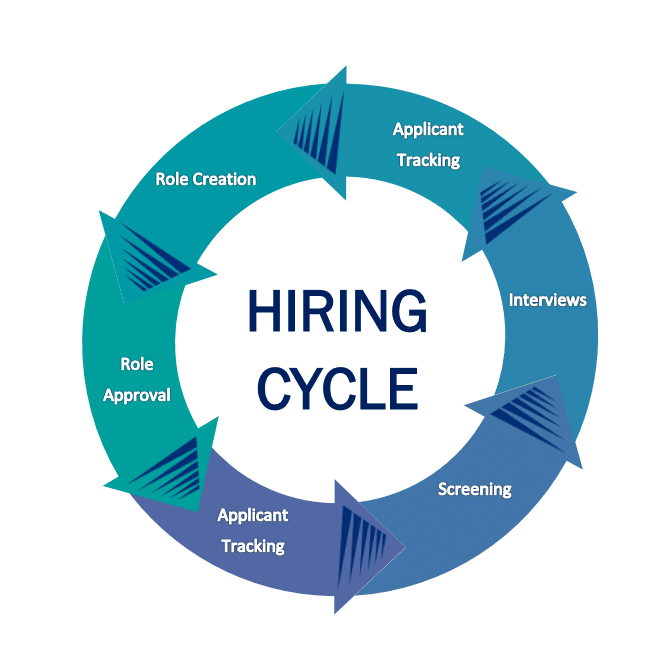The average hiring cycle has risen sharply in the past few years (from 13 days to over 23 days). Some positions take even longer—2 months or more to make a hire. All of this lost time slows down team momentum and actually leads to a sloppier hiring process, not a more careful one. Not only that, many of the top job candidates are off the market in 10 days or less. Companies that take a long time to hire are depriving themselves of the best talent in the industry.
This year, aim to slash the hiring time by 50%. Here are the best ways to cut down lag time on a new hire:
Diagnose the problem areas
Start by taking a quick look at the numbers. How long did it take to hire the last 3 employees? Break down the hiring process into role creation, role approval, applicant tracking/sourcing, screening, interviewing, and extending the offer. Which takes the most time? Where can the process be sped up? Most companies lose steam in screening and interviewing candidates.
Plan out the hiring cycle
Set a deadline for onboarding the new hire. While most hiring cycles do not go exactly according to plan, having a deadline creates an incentive for good time management and fast responses. It is a common pitfall to subconsciously underestimate the time it takes to make the hire.
Start by coordinating the schedules of everyone involved in making the hire. Most companies try to get too many people involved in the hiring process, which can create confusion and delays. Best practice is to include the person who will be directly managing the employee, someone who can drill them on the technical skills, and preferably one team member who would be working alongside them.
If one of the hiring managers will be traveling, overloaded, or working on a complex project, consider reassessing the hiring timeline or cutting them out of the hiring process altogether. Good candidates may stick it out for a long hiring process, but most won’t.
Urgency bonus
Sometimes, a long hiring cycle happens when a manager is afraid of hiring the wrong person. This is a valid concern, because bad hires are expensive—but so is a long hiring cycle. A delayed hire can mean expensive overtime, overworked team members, missed deadlines, or even falling behind in market competitiveness.
For companies that work with recruiters (internal or external), an urgency bonus is a great incentive to keep things moving. The bonus should be enough to overcome the temptation to procrastinate, but not so big that the hiring manager is tempted to rush the hire.
Resist “Mini Me” and “Queen Bee” Syndrome
Most hiring managers want to hire someone with a similar industry background and skill mix, essentially, someone whose resume looks just like their own…minus 5 years of experience and 25% in salary, give or take. The reality is that it’s more comfortable to hire “mini me” people with a similar background, but the strongest and highest-performing teams are diverse—in strengths as well as in personality.

Avoid “mini me” syndrome in a hiring cycle. The best teams have diverse work histories.
The other pitfall to avoid is “queen bee” syndrome. It can be tempting to always go after the perfect candidate with the strongest career path, best leadership qualities, impeccable background, and every skill under the sun. Not only are these “queen bee” candidates rare and expensive, but they also often are not what is needed. Most teams are made up of worker bees. Resist the urge to insist on every skill, and assess what is truly needed in the role.
Training Skills and “Bend” Points
In today’s market, there is a resistance to on-the-job training at nearly every seniority level. Many hiring managers overestimate the amount of experience they need in a candidate, but they underestimate what someone can learn on the job. Keep in mind that a newly hired person is more likely to put in extra hours and extra work to close their skills gap. In many cases, hiring managers wait around for an extra 3 months for the perfect candidate, when they could have hired someone slightly less senior and trained them on the job in less time than it took to find them.
Backfills vs. New Roles
In the staffing industry, recruiters know that backfills nearly always get filled faster than newly created positions. In fact, many new roles change several times during the hiring process. Many never get filled at all. This is because backfill roles are under pressure to fill. Keep this in mind when creating a new role. It is a huge time drain to get everyone involved in a hiring project that may change three times and still take six months to fill.
Most hiring managers prefer to focus on their projects, not on drawn-out hiring cycles. Cutting down the hiring cycle time benefits everyone. It takes dedication, so set multiple milestones if necessary. By slashing wasted time in the hiring process, companies will boost morale, get on top of projects faster, and hit their goals at a better rate than the competition.

